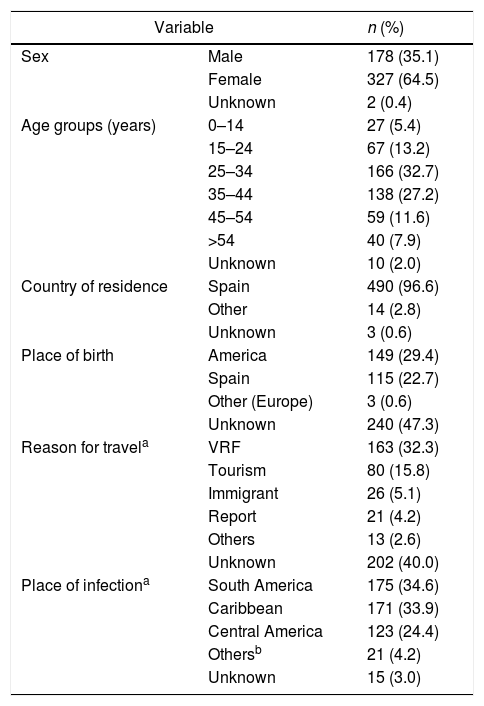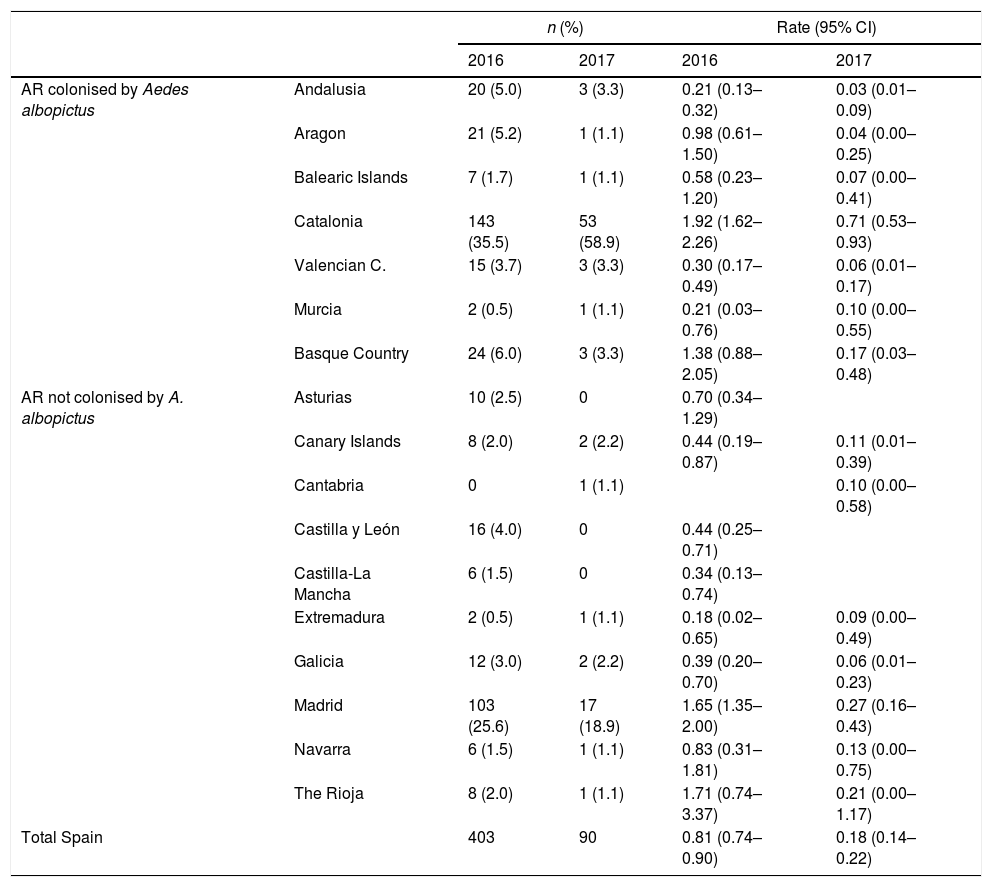Zika virus disease is a challenge for public health due to its rapid spread and potential foetal complications. Although it is imported in Spain, there is a risk of autochthonous transmission due to Aedes albopictus presence. Zika disease and congenital cases have been under surveillance since 2016. The objective of this study is to explore the epidemiology of disease and pregnancies result.
Material and methodsA descriptive study was carried out into cases reported to the National Surveillance Network (RENAVE) during the 30/11/2015 to 31/12/2017 period. The case definition and the survey are included in the RENAVE protocol. The variables were: date; notifying region (Autonomous Community (AC)); pregnancy and its evolution; case classification; mode of transmission; country or region of infection; socio-demographical, clinical and microbiological data. A descriptive analysis of the cases and their distribution according to the other variables was carried out.
ResultsA total of 512 cases were reported by 17 ACs. 507 were non-congenital, of which 327 (64.5%) were women (52.5% of childbearing age). 403 cases (79.5%) corresponded to 2016 and 193 (38.1%) resided in regions with A. albopictus presence between May and October. 96.1% of imported cases were infected in America (51.7% while visiting relatives). Three cases (3.9%) of congenital Zika virus infection were detected among 77 pregnant women.
ConclusionsThe evolution of reported cases was in accordance with that of the epidemic in America. The largest group of travellers was young women who travelled to Latin America on family visits. Pregnancy monitoring resulted in the identification of Zika related foetal complications.
La enfermedad por virus Zika constituye un reto para la salud pública por su rápida expansión y sus potenciales complicaciones fetales. En España la enfermedad por virus Zika es importada, aunque la presencia de Aedes albopictus no descarta su transmisión autóctona. La enfermedad por virus Zika y los casos congénitos se vigilan desde 2016. El objetivo es conocer su epidemiología y el resultado de la gestación en las embarazadas.
Material y métodosEstudio descriptivo de casos notificados a la Red Nacional de Vigilancia Epidemiológica (RENAVE) entre el 30/11/2015 y el 31/12/2017. La definición de caso y la encuesta se recogen en los protocolos de la RENAVE. Las variables fueron: fecha, comunidad autónoma (CC.AA.), clasificación, modo y lugar de infección, variables sociodemográficas, clínicas, microbiológicas, embarazo y su evolución. Se realizó un análisis descriptivo de los casos y su distribución según el resto de variables.
ResultadosDiecisiete CC.AA. notificaron 512 casos, de los cuales 507 fueron no congénitos: 327 (64,5%) eran mujeres (52,5% en edad fértil); 403 casos (79,5%) correspondieron a 2016 y 193 (38,1%) residían en CC.AA. colonizadas por A. albopictus entre mayo y octubre. El 96,1% de casos importados se infectaron en América y el 51,7% en visitas familiares. Se detectaron 3 casos de infección congénita en 77 embarazadas.
ConclusionesLa evolución de notificaciones mostró paralelismo con la de la epidemia en América. El grupo más numeroso de viajeros fue el de mujeres jóvenes que fueron a Latinoamérica en visitas familiares. El seguimiento de las embarazadas permitió identificar complicaciones fetales.
Artículo
Comprando el artículo el PDF del mismo podrá ser descargado
Precio 19,34 €
Comprar ahora












